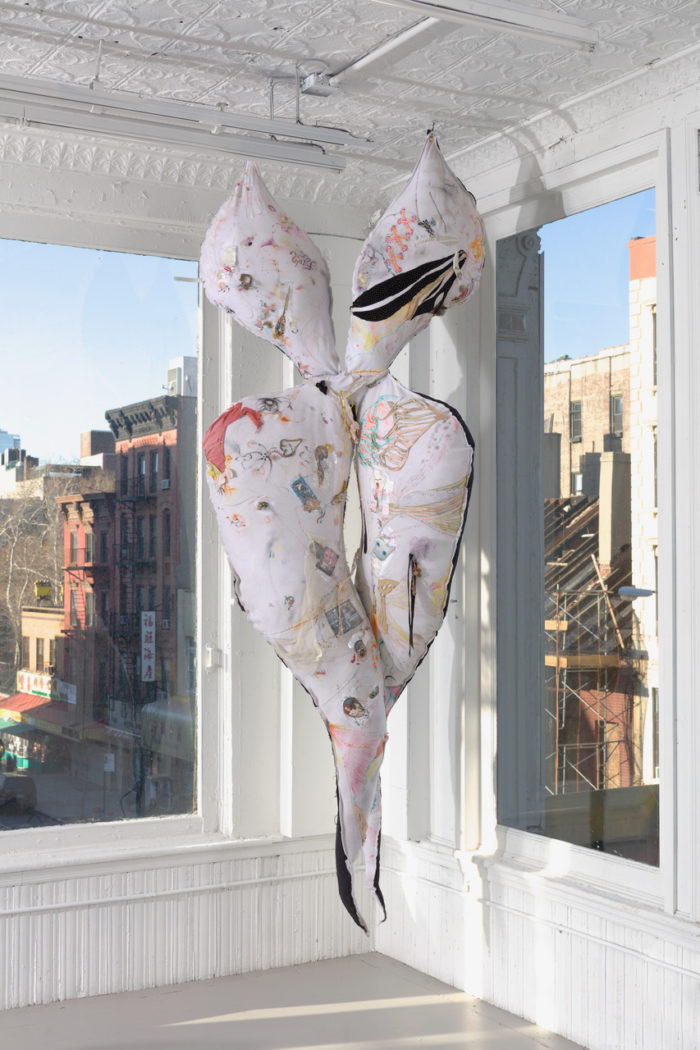
A pair of scissors slowly cuts open a paper doorway. There are many people sitting on the floor cross-legged around an artificial turf walkway that functions as a runway. Heavy sounds thump. Overhead a woman’s voice whispers, “I love you forever.” The scissors cut higher, they round slowly, the blade catches the light, mauve skirts in impossible layers sway in effort, an apron is revealed, the silk reflects the lights and the paper door slouches outward. A woman appears. She smiles and slowly, stilted, she walks. So begins Mew+, the fourth runway presentation for Women’s History Museum, a collaboration between Amanda McGowan, Mattie Rivkah Barringer and a rotating number of other artists and thinkers. Weaving its way through Women’s History Museum’s layered, multivalent, collaborative practice is a gathering inward to create another universes. Each garment Women’s History Museum makes is a detailed collage that speaks directly to the body beneath. Etymologically, a museum was a temple to the muses; what is a museum if it is not pillaged from the bodies of women, of others?
Each new collection is unveiled as a performance. Whether a circular presentation reminiscent of a maypole at St. Mark’s Church or a distorted theatrical play with RiichPSYCHO (Ajakia Smith) and Just the Right Height (Keke Hunt), every performative iteration incorporates the many facets of Women’s History Museum’s practice: sculpture, performance, garments and sound. McGowan and Barringer use materials with previous lives, materials that have been weathered and continue on. Their use of antique fabrics and patterns that speak to the history of women’s clothing produces a delicacy that is maintained through all four of their collections, balancing so finely and easily into forms that are constantly surprising no matter their presentation. Whether worn by one of Women’s History Museum’s collaborators like Gogo Graham and Jahmal B Golden, or hanging ghostlike from a ceiling, in these new forms there is a sense of reclamation.

Barringer reminds me that this action of working with things that might be considered old honors those who came before, a joining which produces a humbling sensation. A dialogue in the present with the many women of the past.
McGowan and Barringer took me through “OTMA’s Body,” their first exhibition at Gavin Brown’s enterprise on the Lower East Side. A pseudo- retrospective, the exhibition presented multiple new wall and sculpture pieces, two films on a loop, ready-to-wear and garments from all four of Women’s History Museum’s collections. “OTMA” is the acronym used by the four final grand duchesses of Russia: Olga, Tatiana, Maria and Anastasia Romanova. OTMA, taught to self-negate from a young age, left behind diaries, toys and endless photographs of one another; OTMA, only useful when married off to princes. The story of OTMA’s lives are a loose fulcrum on which to pivot the ideas Women’s History Museum teases through their Gavin Brown show.
OTMA spent their lives sequestered. Barringer notes that access to our community has moved further into private domestic spaces; communion happens behind closed doors. Barringer and McGowan work from home. The new sculptural and furniture pieces debuted in “OTMA’s Body” like The Tsarina’s Fainting Sofa and Devil Kitty Heart Tapestry (both 2018) are tokens of this turning inward; they are extensions of the domestic and those who dwell within it. When the furniture resides in the gallery, the space then becomes a pseudo-sanctuary.
This ability of OTMA to self-negate sounds like a way of maintaining the body as neutral, nullified as a form of mindful non-participation. “I think this phrase, body neutrality, is something our friend Chloé Maratta said to describe how I and Amanda dress and tend to dress others,” observes Barringer. “Which I take to mean, taking an active stance in ignoring received notions around dressing and how to articulate our bodies in society. And obviously, no one’s body or experience is neutral. It’s more of a hope to reimagine what could be, with dressing as a conduit.”

McGowan explained that the reclaimed materials used by Women’s History Museum are in conversation with the female hands of history. Whether it is hinted at in the original patterns (a corset, a nurse’s bonnet, a quilt), implied in these material outputs is a sense of softness, and with that softness comes an inevitable conversation with decay. Like Marisa Merz’s latex, like Eva Hesse’s rubber, like Senga Nengudi’s nylon, one might think that by looking at something soft they might be able to get inside of it. But as the object is in a state of constant motion, how could it be entered into?
Following from “OTMA’s Body” and from their play at Performance Space New York, McGowan and Barringer are not interested in limiting themselves to one medium or particular output. What’s next for Women’s History Museum? it’s about more: more exhibitions, more collections, more performances, more collaborations, more films.
Their practice continues and I follow, waiting for their next articulation. I wait patiently, because what comes forth as bodies of work from Women’s History Museum function as part of a larger diorama of how the artists would like things to be. The works of Women’s History Museum might be considered as a series of tools (aids) for an uncertain future; to adorn, to reflect, to behold, to be held, to hold.




